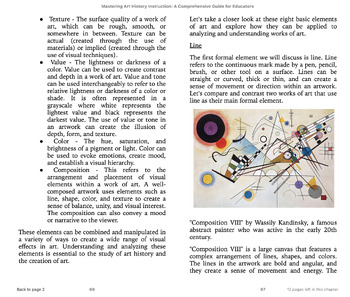Mastering Art History Instruction: A Comprehensive Guide for Educators
Description
Please note: This is a zip download and contains both .epub and .pdf format. Preview the contents by watching the video above.
Mastering Art History Instruction: A Comprehensive Guide for Educators is designed to equip art educators with the knowledge and tools necessary to teach art history effectively. With 300+ pages of content, this comprehensive guide covers a range of topics, from the importance of art history education to strategies for cultivating a passion for the subject in students.
Contents
Chapter 1: Introduction to Art History
- What is Art History?
- How is Art History taught in schools?
- Why is Art History important?
- Periods, Movements, Styles
- Art History Timelines
- Themes in Art History
- Key Theories in Art History
- How is Art History relevant to education today?
Chapter 2: Teaching Visual Analysis
- Visual Analysis
- Elements of Art
- Principles of Design
- How do formal elements and principles of design work together?
- Visual Cues
- Visual Analysis Frameworks: Formal Analysis, Thematic, Compare and Contrast
Chapter 3: Effective Teaching Strategies for Art History
- Pedagogy in Art History: Inquiry-based learning, Visual Literacy, Multicultural Education
- Other pedagogical considerations
- Critical thinking and observation skills
- Active Learning Strategies
- Writing About Art
- Lesson Planning
- Visiting a Museum or Art Gallery
- Teaching Cross-Curricular
- Resources and Sources
Chapter 4: Enhancing Art History Instruction with Technology
- Tools and Strategies
- Art History Instruction and PowerPoint
- Virtual Museums
- Software and Apps
- Art and Technology Lesson Plan
Chapter 5: Assessment and Feedback in Art History Instruction
- Designing effective assessments
- Constructive Feedback
- Reflection Framework
- Example Visual Analysis Assessment Rubric
- Using a Visual Journal
- Monitoring Student Progress
- Peer Learning
- Student Presentations: Communicating Art History
Chapter 6: Cultivating a Passion for Art History
- Inspiring curiosity and appreciation
- Make it relevant
- Encourage critical thinking, creativity and interdisciplinary connections
- Art History Skills
- Stay Connected
Conclusion: Creating an Action Plan for Teaching Art History
- Creating an Action Plan
- Reflective Journal Rubric
Supplementary materials provided:
- Reading list, resources and image databases
- Image list
- Bibliography
- Action Plan Rubric
- Art History Timeline
- Suggested Rubric for Teaching Art History
- Visual Analysis Framework for Students
- Compare and Contrast Visual Analysis Worksheet
The book begins with an introduction that welcomes readers and highlights the significance of teaching art history. It provides an overview of the course content and offers guidance on how to make the most of the e-book's resources. The first chapter, "Introduction to Art History Instruction," explores the value of art history education and introduces key art historical periods, movements, and styles. It emphasizes the relevance of art history in contemporary education and provides suggested activities and discussion questions to engage students. The second chapter, "Teaching Visual Analysis," delves into the elements of art, principles of design, and visual cues. It presents various visual analysis frameworks, such as formal analysis, thematic analysis, and comparative analysis. The module includes suggested activities and discussion questions to help students develop their analytical skills.
"Effective Teaching Strategies for Art History," the third chapter, focuses on incorporating active learning strategies into art history instruction. It provides guidance on developing lesson plans, instructional materials, and fostering critical thinking and visual analysis skills in students. Suggested activities and discussion questions encourage educators to create engaging learning experiences. The fourth chapter, "Enhancing Art History Instruction with Technology," explores the integration of technology tools and resources. Educators will learn how to utilize virtual museum tours, online art collections, multimedia presentations, and interactive activities to enhance student engagement. The module includes practical activities and discussion questions to facilitate the implementation of technology in the classroom.
Chapter five, "Assessment and Feedback in Art History Instruction," addresses the design of effective assessments to measure student learning in art history. It provides insights on providing constructive feedback to students and emphasizes the importance of reflection and adjusting instruction based on student progress. The chapter includes suggested activities and discussion questions to aid educators in assessing their students' understanding. In the sixth and final chapter, "Cultivating a Passion for Art History," educators will discover strategies for inspiring students' curiosity and appreciation for art history. It explores methods to encourage critical thinking, creativity, and interdisciplinary connections. Suggested activities and discussion questions stimulate educators to foster a lifelong love for art and its history in their students.
The conclusion encourages readers to reflect on the key concepts and strategies learned throughout the course. It guides educators in creating an action plan for implementing effective art history instruction and celebrates their growth as skilled and confident art history educators. Additional resources and references are provided to further support their journey.




